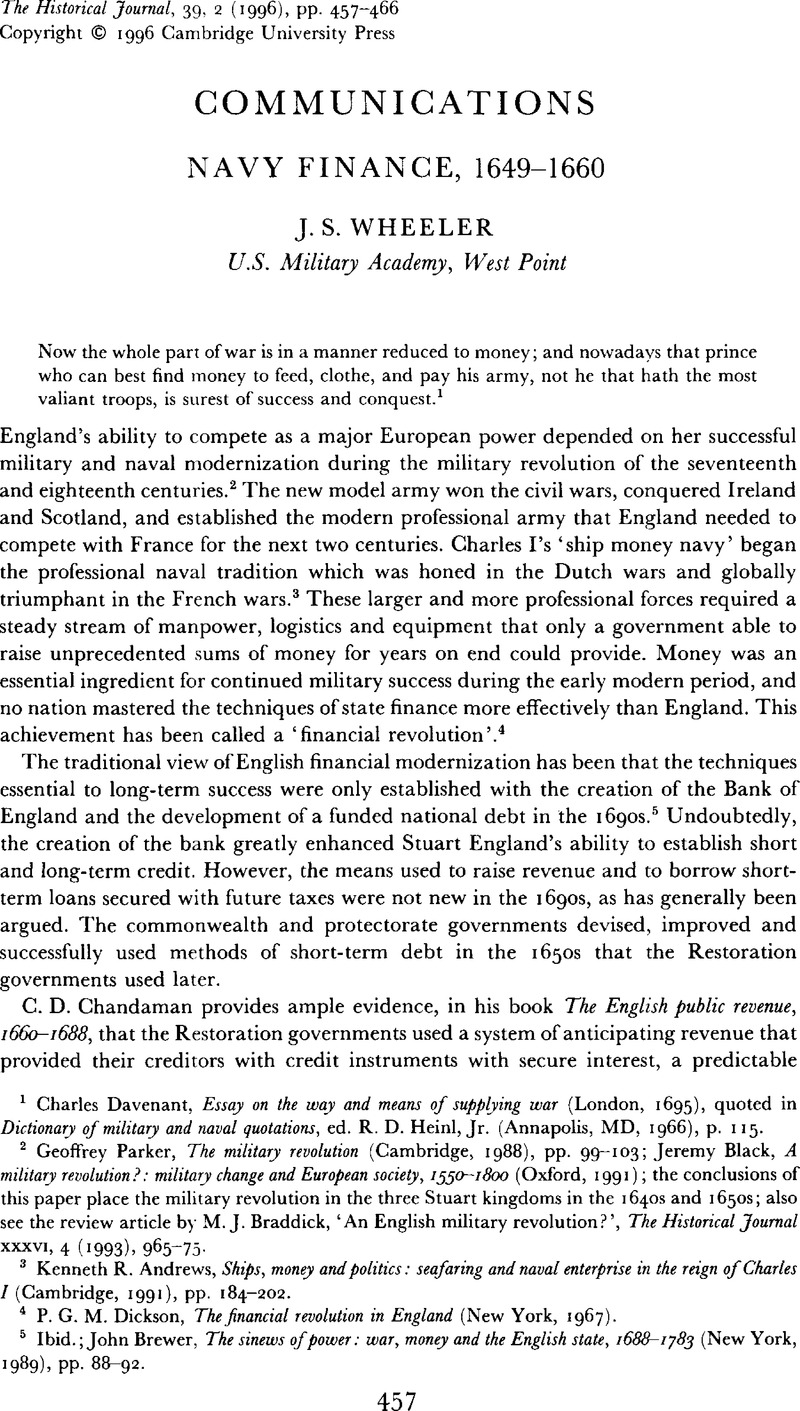Article contents
Navy Finance, 1649–1660
Published online by Cambridge University Press: 11 February 2009
Abstract

- Type
- Communications
- Information
- Copyright
- Copyright © Cambridge University Press 1996
References
1 Charles, Davenant, Essay on the way and means of supplying war (London, 1695)Google Scholar, quoted in Dictionary of military and naval quotations, ed. Heinl, R. D. Jr. (Annapolis, MD, 1966), p. 115.Google Scholar
2 Geoffrey, Parker, The military revolution (Cambridge, 1988), pp. 99–103Google Scholar; Jeremy, Black, A military revolution?: military change and European society, 1550–1800 (Oxford, 1991)Google Scholar; the conclusions of this paper place the military revolution in the three Stuart kingdoms in the 1640s and 1650s; also see the review article by Braddick, M. J., ‘An English military revolution?’, The Historical Journal XXXVI, 4 (1993), 965–75.CrossRefGoogle Scholar
3 Kenneth R., Andrews, Ships, money and politics: seafaring and naval enterprise in the reign of Charles I (Cambridge, 1991), pp. 184–202.Google Scholar
4 Dickson, P. G. M., The financial revolution in England (New York, 1967).Google Scholar
5 Ibid.; John, Brewer, The sinews of power: war, money and the English state, 1688–1783 (New York, 1989), pp. 88–92.Google Scholar
6 Chandaman, C. D., The English public revenue, 1660–1688 (Oxford, 1975), p. 296.Google Scholar
7 Ibid. p. 287.
8 Ibid. pp. 296–7.
9 Lawrence, Stone (ed.), An imperial state at war: Britain from 1689 to 1815 (London, 1993)Google Scholar; see also Jonathan Clark's review of Stone's piece in the Times Literary Supplement, 11 March 1994, pp. 11–12Google Scholar. Clark concludes that the fact that ‘Chandaman and Braddick, who have shown the state's effective tax-raising powers extending back through the Restoration to the Commonwealth’ undermines the periodization of Stone's collection.
10 Great Britain, P[ublic] R[ecord] O[ffice], E351/2287–2292, ‘The Declared Accounts of the Navy Treasurers’ (hereafter cited PRO).
11 PRO E351/2287–2296.
12 Ibid.; the first two folios of each account lists all sources of revenue provided to the treasurer during the year of the account.
13 Maurice, Ashley, Financial and commercial policy under the Cromwelhan Protectorate (Oxford, 1934).Google Scholar
14 Richards, R. D., ‘The exchequer in Cromwellian Times’, Economic History, Jan. 1931, pp. 213–23Google Scholar; PRO E351/2289–96, only £5,662 came from fines and the sale of state property in the period after 1651. In spite of the clear evidence available in the navy treasurers' accounts, the fact that well over 80 per cent of the money provided to the navy came from taxation is generally not known. For example, Paul, Kennedy states, in his book The rise and fall of British naval mastery (London, 1976)Google Scholar that ‘the greatest part of the funds for the Commonwealth navy came out of sequestered royalist lands’ (p. 45). In reality the navy treasurers' accounts for the commonwealth period of 1649 to 1660 indicate that only in 1650 did even as much as 37 per cent of the receipts come from these sources. 15 PRO E351/2289, end of the account; E351/2292, fos. 1–3.
16 PRO E351/2296, end of the account.
17 Brewer, , Sinews of power, pp. 114–22.Google Scholar
18 Bodl[eian Library]., Rawlinson MSS A208, ‘Account Book of the Treasurers at War’, fos. 458–62. From August 1653 to August 1655, £726,233 in cash was provided to the Treasurer of the Navy, Richard Hutchinson, by the treasurers ar war, Richard Deane and John Blackwell; PRO, E351/302-6 and 308, ‘The Declared Accounts of the Treasurers at War, 1645–1660’: the treasurers at war paid £1,025,174 to the navy treasurer from 1652 to December 1655; also see E351/2289–96, fo. 2 of each account for the amount received by the navy treasurers each year. After 1655 the treasurer of the navy's accounts list no receipts from the assessment treasurers who were also the treasurers at war.
19 Calendar of State Papers, Domestic, 1651–52, pp. 359–60.Google Scholar
20 PRO E351/2293, fos. 32–7, the total debt owed for these years was reduced from £705,590 to £164,878 by December 1655. £540,712 in debt was paid off, or 76 per cent of the total accrued in the four years 1650–3.
21 Kennedy, , British naval mastery, pp. 45–6Google Scholar; Marcus, Oppenheim, A history of the administration of the Royal Navy 1509–1660 (Camden, CT, 1961), p. 306.Google Scholar
22 Bodl., Rawlinson MSS A187, pp. 56, 90, 94.
23 Ibid.
24 PRO E351/2296, fos. 1–3.
25 PRO E351/308; Firth, C. H. and Rait, R. S., Acts and ordinances of the interregnum (London: HMSO, 1911), II, 1234.Google Scholar
26 Brewer, , The sinews of power, p. 88.Google Scholar
27 Calendar of treasury books, 1660–1667 ed. William, Shaw (London: HMSO, 1904), pp. xiii–xiv.Google Scholar
28 Braddick, , ‘An English military revolution?’, p. 975.Google Scholar
- 3
- Cited by




